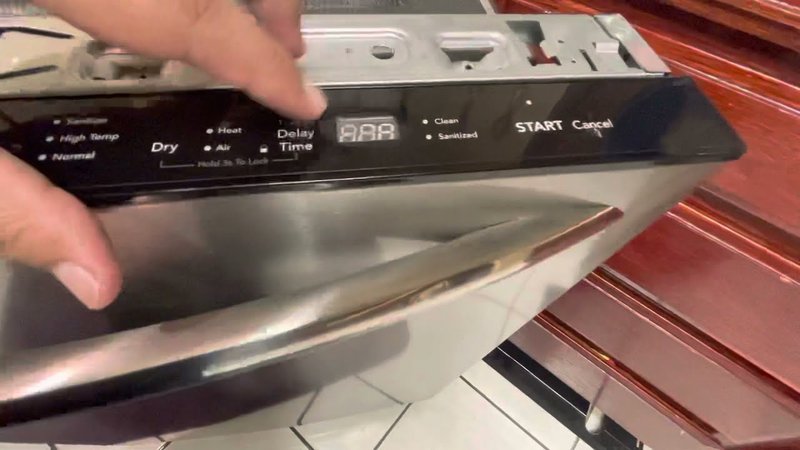
Let’s unpack this mystery together. Just like how a car’s check engine light warns you of potential issues, your Frigidaire dishwasher uses error codes like E2 to flag problems that need attention. Understanding these codes not only helps you fix the current issue but also aids in preventing future hiccups. Imagine error codes as your appliance’s way of holding up a sign saying, “Hey, I need a little TLC!” And don’t worry, deciphering these signs doesn’t require a degree in engineering. With a clear breakdown, you’ll have it all figured out.
Deciphering the E2 Error Code
The E2 error in your Frigidaire dishwasher points to a drainage issue. Think of it like trying to empty a bathtub, where the water just won’t go down due to a clog. In technical terms, the dishwasher is sensing that the water isn’t draining out properly. When this happens, your appliance is simply alerting you to a potential cause, which might be a clogged filter or a kinked drain hose.
So, why does this happen? Often, food particles or debris can block the dishwasher’s drainage system. The dishwasher, much like any appliance relying on water, needs a clear pathway to expel used, dirty water and make room for the fresh stuff. If something’s obstructing that path, the machine halts, signaling you with the E2 code. This isn’t just about cleanliness; it ensures the dishwasher functions efficiently without straining its parts.
Here’s what you can do: Start by checking the bottom of the dishwasher for any visible blockages. Sometimes, the solution is as simple as removing a stray piece of food. If nothing seems amiss, the next step is to inspect the drain hose. Is it kinked or blocked? Straightening it out or clearing it could be just the fix needed. When in doubt, a quick read of your user manual can offer diagrams and further guidance specific to your model.
Common Causes and How to Fix Them
Let’s dig a little deeper into why you might be seeing this E2 error. One prevalent cause is a blocked filter. The filter, situated at the bottom of your dishwasher, catches bits of food and grime, preventing them from circulating through the system. Over time, it’s natural for the filter to become clogged, especially if it’s not cleaned regularly. Picture trying to sip a smoothie through a straw clogged with pulp—frustrating at best. In the dishwasher’s case, it slows down drainage, leading to the E2 code.
Another frequent culprit is the drain hose itself. Like a garden hose with a bend, any kink can reduce water flow to a trickle or halt it entirely. To troubleshoot, locate the hose, check for any bends, and ensure it’s securely attached with no cracks or leaks. At times, even the most cautious users might find debris like tiny pieces of broken glass or fats that solidified, creating blockages.
If these steps don’t resolve the issue, it might be a deeper mechanical problem involving the drainage pump. While tackling the pump is not a beginner task, recognizing when to call a professional is crucial. A service technician can quickly identify if the pump is faulty and needs replacing, saving you time and potential headaches. Remember, while DIY fixes are excellent, knowing your limits ensures your dishwasher remains in peak condition.
Preventive Measures to Avoid Future Error Codes
Preventive maintenance is your best friend when it comes to avoiding error codes like E2. By regularly cleaning the filter, you can avoid most clogs before they even start. Think of this as giving your dishwasher a spa day—a little TLC goes a long way. Aim to check and clean your dishwasher filter every month, particularly after heavy usage. It’s a simple task that can prevent build-ups and ensure smooth drainage.
Additionally, be selective about what goes into your dishwasher. Scrape large food scraps off plates before loading them, just as you wouldn’t throw a huge log into a delicate fireplace. This small habit reduces the debris load and prolongs your dishwasher’s life. Also, consider running an empty hot water cycle with a cup of vinegar occasionally. This helps break down any accumulated grease or grime, much like a detox cleanse.
If you ever feel uncertain, remember that your user manual is a treasure trove of information. It’s tailored to your specific model and can offer tips and diagrams to guide regular maintenance. A little time invested in upkeep can save you from future frustrations and keep your dishwasher running smoothly, ensuring you spend more time enjoying your meals than worrying about washing up.
So, the next time you encounter the E2 error, you’ll know exactly what it means and how to tackle it. Your dishwasher might beep and display codes, but with some attention and care, you’ll have everything under control.